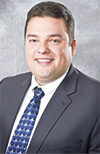Researchers and the dairy science community joined together in July in Kansas City, Missouri, for the 2014 Joint Annual Meeting held by the American Dairy Science Association (ADSA) and the American Society on Animal Science (ASAS).
Several topics related to animal behavior and well-being, animal health, genetics, dairy management, animal nutrition, milk quality and physiology of reproduction were discussed in this five-day event with more than 2,000 abstracts presented through posters and oral sessions.
Here are a few highlights from the meeting pertaining to reproductive efficiency.
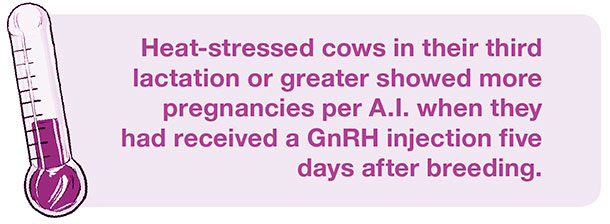
Could another hormone injection improve reproductive efficiency?
In a large study (2,885 cows) conducted by Dr. Luis Mendonça at Kansas State University, pregnancies per A.I. (P per A.I.) were evaluated for heat-stressed cows that received an injection of gonadotropin-releasing hormone (GnRH) after being observed in estrus based on tail paint removal observed once a day.
Cows were divided into four groups: Control cows did not receive any intervention at A.I.; G-0 cows received one injection of GnRH at A.I.; G-5 cows received a GnRH injection five days after A.I.; and G-0 + G-5 cows received one GnRH injection at A.I. followed by another injection five days later.
Overall, treatment with GnRH at A.I., five days later and the interaction between these two strategies did not affect P per A.I. (all treatments were around 26 percent P per A.I.), but an interesting interaction was observed based on parity, where cows on their third and greater lactations that received a GnRH treatment five days after A.I. had their P per A.I. increased compared to first-lactation and second-lactation cows (27 percent versus 19 percent, respectively).
Another recent discussion has questioned the benefits of adding one prostaglandin (PGF) injection 24 hours after the regular PGF injection within the Ovsynch protocol to improve fertility.
To answer this question, Dr. Paul Fricke and collaborators at the University of Wisconsin – Madison enrolled cows in four different treatments: Control animals received the standard Ovsynch-56 protocol for timed A.I. (GPG); GGPG cows received a pre-synchronization injection of GnRH six days before the onset of the Ovsynch-56 protocol; GPPG cows had an extra PGF injection administered 24 hours after the regular injection within the Ovsynch-56 protocol; and GGPPG cows received both injections, a pre-synchronization with GnRH six days before the protocol and an extra PGF injection within the protocol.
No differences were observed for cows on these four different treatments for first service after calving. However, when the resynchs (second and greater timed A.I. after non-pregnancy diagnosis) were evaluated, cows that received the pre-synchronization injection of GnRH with extra PGF showed better P per A.I. (42 percent for GGPPG, 34 percent for GPPG, 28 percent for GGPG and 27 percent for GPG).
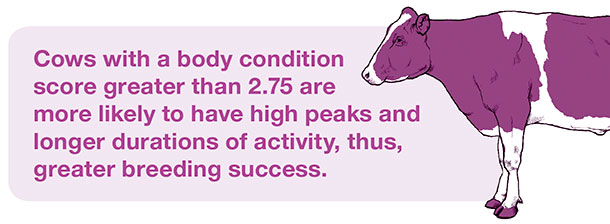
Maximizing estrus detection to improve reproductive performance
In an attempt to improve reproductive performance in a herd by submitting more cows to A.I. after observation of estrus, more and more producers are investing in the new generation of activity monitors, also known as accelerometers.
Dr. Ronaldo Cerri and collaborators at the University of British Columbia tried to outline factors such as parity, body condition score (BCS), milk production and pre-ovulatory follicle diameter with estrus expression in lactating dairy cows using activity monitors and then correlate the results with P per A.I..
On these factors, only BCS was highly associated with the percentage of cows with high peak of activity or percentage of cows with long duration of activity. Cows with low BCS (2.5 or less) were less likely to have high peak of activity and long duration of activity when compared to moderate (2.75 to 3) and high (3.25 or greater) BCS.
Cows with high peak of activity (90 to 100 units above the base line) had better performance after A.I., reaching 37 percent P per A.I. when compared to cows with low or moderate peak of activity (35 to 89 units).
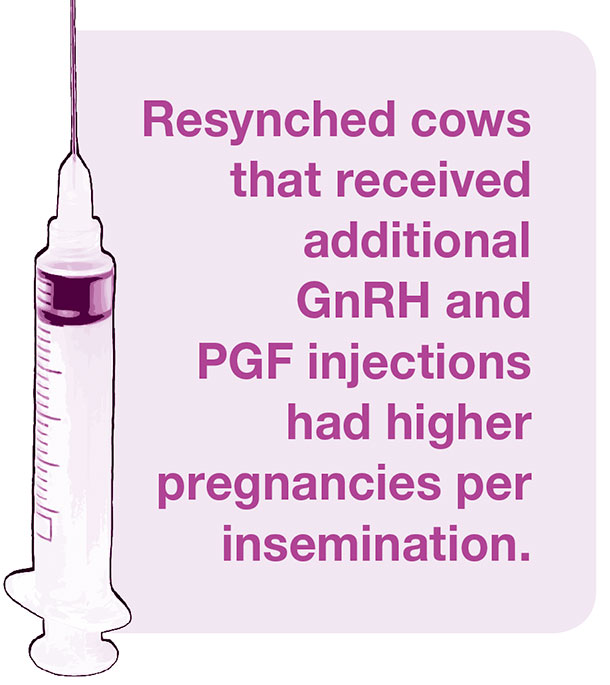
Along those lines, Dr. Julio Giordano at Cornell University evaluated a program for resynchronization that aimed to maximize A.I. in estrus and fertility based on ovarian structures present at the non-pregnancy diagnosis (NPD), referred to as the “treatment” group, and compared it to the standard Resynch starting 32 days after previous A.I., referred to as the “control” group.
Treatment cows were divided based on the presence or absence of a corpus luteum (CL) at NPD. Cows with a CL received a PGF injection and were monitored for estrus expression by activity monitors for nine days, then received a five-day Ovsynch protocol with progesterone supplementation.
Cows with no CL received a presynchronization injection of GnRH and started the same five-day Ovsynch protocol seven days later. In this group, 65 percent of cows had a CL at NPD and were treated with PGF, but surprisingly, only 38 percent of them were detected in estrus by the system.
With these results, cows in the treatment group were inseminated in a lower rate when compared to those in the control group. Overall, fertility data did not differ among treatments, neither for cows receiving A.I. in estrus or after timed A.I.
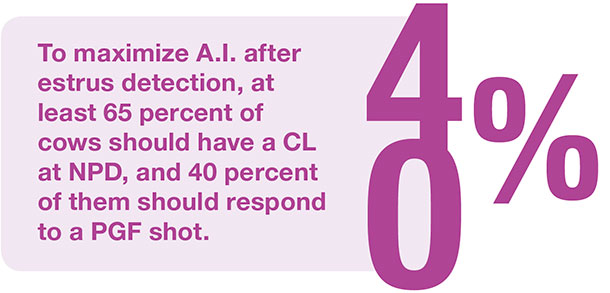
Giordano concluded that a successful reproductive program that aims to maximize A.I. after estrus detection needs to have at least 65 percent of cows with a CL at NPD and that at least 40 percent of those cows should respond to the PGF injection. In addition, a synchronization program for timed A.I. needs to be implemented right after the period of estrous detection ends.
As we have noticed, different strategies can be used to manage reproduction on a dairy, and researchers have been working hard to better understand the relationship between physiology and practice in order to help producers in their daily decisions.
However, it is important to emphasize that the combination of strategies and the respect for individual herds’ needs are the two major components to take your reproductive success to reach the next level. PD
Glaucio Lopes is a veterinarian graduate from Brazil, and he received his master’s degree in reproduction of dairy cows at the Department of Dairy Science at the University of Wisconsin – Madison. He is employed by Accelerated Genetics as a reproduction specialist.

-
Glaucio Lopes
- Reproduction Specialist
- Accelerated Genetics
